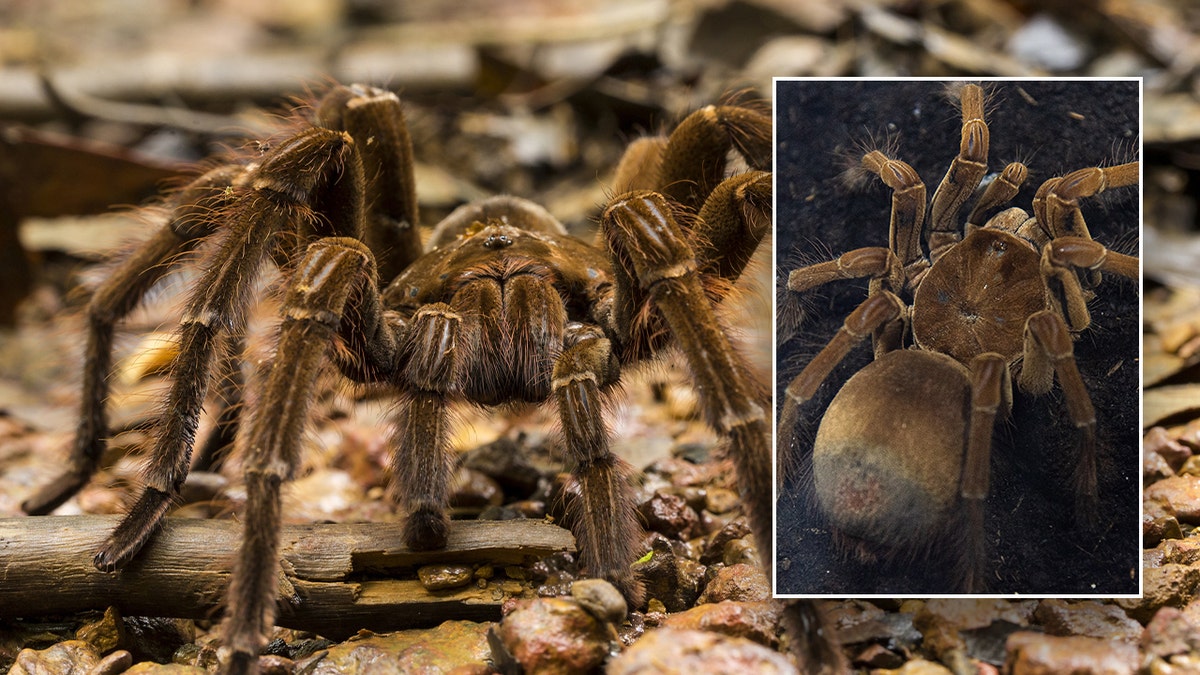These spiders won’t bother you if you don’t bother them: research scientist
University of Georgia assistant research scientist Andy Davis explains how the giant Joro spiders are making a return along the East Coast of the United States on ‘The Ingraham Angle.’
The Goliath birdeater's massive size earns it the title of the world's largest spider.
The Goliath birdeater, or theraphosa blondi, if using the scientific name, is ranked the largest for its overall size and mass.
The massive size can make these spiders very intimidating, but their venom is not lethal to humans, according to National Geographic — though a bite would cause a sting.
LARGEST MALE SPECIMEN OF WORLD'S MOST VENOMOUS SPIDER DISCOVERED IN AUSTRALIA
- How big is the Goliath birdeater?
- Where is the Goliath birdeater found?
- How does the Goliath birdeater catch its prey?
1. How big is the Goliath birdeater?
A typical Goliath birdeater weighs 6 ounces and is typically 11 inches long, according to Discovery Magazine.

The Goliath birdeater is the world's biggest spider, typically measuring nearly a foot long. (iStock)
Its body alone can measure 5 inches long, per the source.
These spiders have a size equivalent to that of a dinner plate.
Their leg span is just slightly shorter than the giant huntsman spider, according to BBC Wildlife Magazine, which is considered the largest spider in the world in terms of leg span. These spiders can have a leg span of around 12 inches.
2. Where is the Goliath birdeater found?
The Goliath birdeater can typically be found in the rainforests of northern South America.
CLICK HERE TO SIGN UP FOR OUR LIFESTYLE NEWSLETTER
The spider spends most of its time tucked away in burrows, waiting for prey.
In certain parts of South America, the Goliath birdeater is known as a delicacy, roasted in banana leaves and served as a dish, according to National Geographic.

The Goliath birdeater is typically found in the rainforest of northern South America. (iStock)
3. How does the Goliath birdeater catch its prey?
Contrary to its name, the Goliath birdeater doesn't often feast on birds, although its large size allows it to do so.
Its name actually can be credited to an 18th-century engraving showing a tarantula eating a hummingbird, according to National Geographic.
Instead, the diet of the spider is mainly made up of insects, according to National Geographic, although frogs and rodents should also look out for the Goliath birdeater as they are part of their diet, too.
For more Lifestyle articles, visit www.foxnews.com/lifestyle
In order to catch its prey, the spider must pounce from above and inject venom from its long fangs into its meal.
Even though the Goliath birdeater has eight eyes, it cannot see very well. Instead of relying on eyesight to spot predators, it instead uses the vibration-sensitive hairs on its legs to alert itself to danger.

The Goliath birdeater has eight eyes, but its eyesight is quite poor, causing the spider to use other methods to detect incoming predators. (Roberto Machado Noa/LightRocket via Getty Images)
To defend itself from predators, which include certain mammals and snakes, the Goliath birdeater rubs its legs together, which sends hairs with tiny stinging barbs at its attacker, according to National Geographic.
Additionally, rubbing its hairs together creates a hissing noise that can be heard 15 feet away, according to the Smithsonian's National Zoo & Conservation Biology Institute.
CLICK HERE TO GET THE FOX NEWS APP
It will sometimes also stand on its hind legs to reveal sharp fangs to its attacker.






















